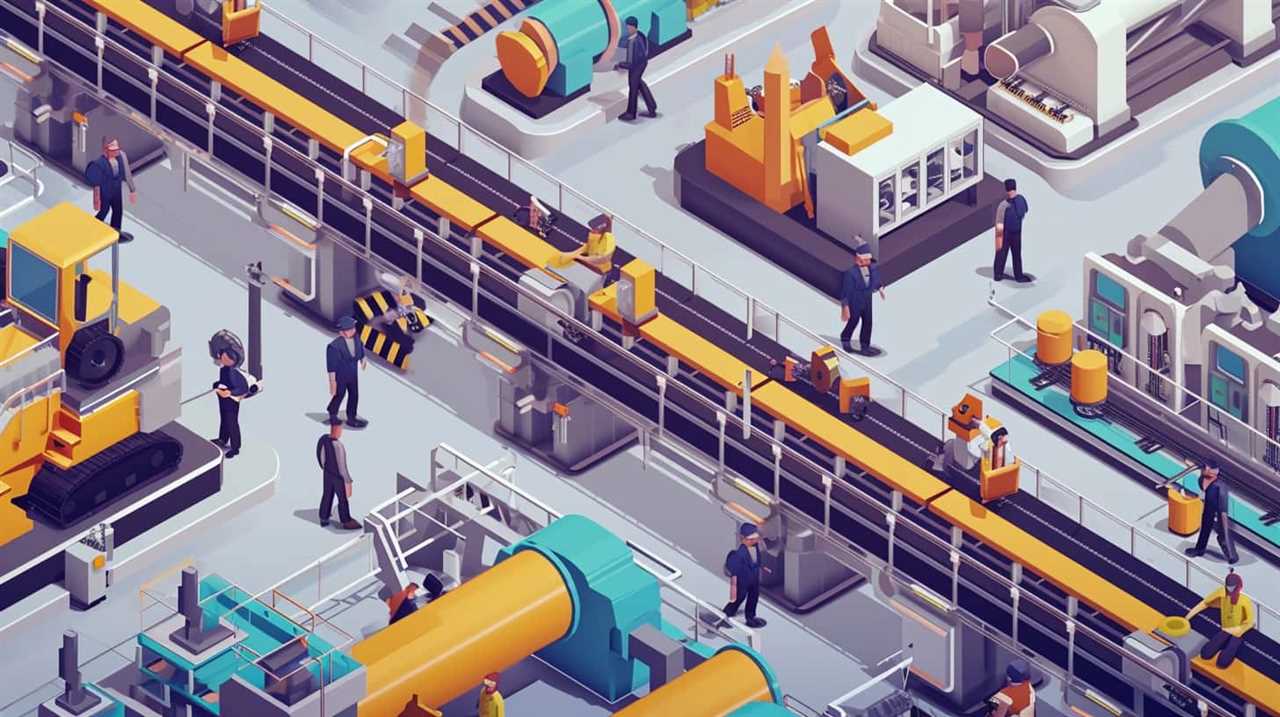Think you know everything about economics? Think again and prepare for a mind-blowing experience! This article delves into Friedrich Hayek’s Price Mechanism Theory, uncovering six eye-opening insights that will change how you view the importance of prices in our society.
From the role of individual knowledge in the price mechanism to the implications for free market policies, Hayek’s theories are a treasure trove of innovation. No more boring lectures on supply and demand – get ready for a journey into the depths of economic enlightenment.
So, fasten your seatbelts, because we’re about to embark on a thrilling exploration of Hayek’s Price Mechanism Theory.
Let’s dive in!

Key Takeaways
- The price mechanism is the process by which prices are determined through the interaction of supply and demand in a free market.
- Individual knowledge influences the functioning of the price mechanism, and decentralized decision-making based on this knowledge promotes competition and efficient resource allocation.
- Supply and demand dynamics play a significant role in market equilibrium and price discovery, which ensure efficient resource allocation.
- Hayek’s critique of central planning highlights the inefficiencies caused by the disregard for the price mechanism, and the importance of market competition and a free market system in promoting innovation and economic growth.
Hayek’s Definition of Price Mechanism
Hayek’s definition of the price mechanism is a fundamental concept that we, as economists, find invaluable in understanding market dynamics. The price mechanism refers to the process by which prices are determined through the interaction of supply and demand in a free market. It plays a crucial role in allocating resources efficiently and coordinating economic activities.
One key aspect of the price mechanism is its role in providing incentives. When prices rise, it signals that there’s excess demand in the market, encouraging producers to increase their output to meet the demand. Conversely, when prices fall, it indicates excess supply, prompting producers to reduce their production. In this way, the price mechanism incentivizes producers to respond to market signals and adjust their behavior accordingly.
Another important function of the price mechanism is its role in promoting market competition. Prices serve as a reflection of the underlying market conditions, and competitive forces drive prices towards equilibrium. When there’s healthy competition, prices are determined by the interaction of multiple buyers and sellers, ensuring that no single entity has excessive control over the market and preventing monopolistic practices.
Role of Individual Knowledge in Price Mechanism
When considering the role of individual knowledge in the price mechanism, several key points emerge.

Firstly, individual knowledge has a significant impact on the functioning of the price mechanism, as it’s through the aggregation of this knowledge that prices are determined.
Secondly, the effectiveness of the price mechanism relies heavily on the accuracy and timeliness of individual knowledge, as any information asymmetries can lead to distortions in price signals.
Lastly, there’s an ongoing debate regarding the relationship between individual knowledge and market efficiency, with some arguing that the market is able to efficiently incorporate and process individual knowledge, while others emphasize the limitations and biases that can arise.
Individual Knowledge’s Impact
Our individual knowledge plays a crucial role in shaping the functioning of the price mechanism. The impact of information and decentralized decision making can’t be overstated in this context.

Each individual possesses unique knowledge about their preferences, needs, and circumstances, which they use to make decisions in the marketplace. This decentralized decision-making process allows for a wide range of choices and promotes competition among market participants.
As a result, prices are determined by the collective interactions of buyers and sellers, reflecting the underlying supply and demand dynamics. Individual knowledge, therefore, influences the information available to market participants, which in turn affects their decision-making processes.
This interplay between individual knowledge and the price mechanism leads to efficient resource allocation, innovation, and adaptation to changing market conditions.
Price Mechanism Effectiveness
While individual knowledge plays a crucial role in shaping the effectiveness of the price mechanism, it’s important to understand the role of information and decentralized decision making.

The efficiency of the price mechanism depends on various factors that influence market dynamics. These factors include:
- Timely and accurate information: The availability of relevant information to market participants enables them to make informed decisions. This ensures that prices reflect the true value of goods and services, leading to efficient allocation of resources.
- Competition: A competitive market encourages participants to constantly seek ways to improve their products and services while keeping prices competitive. This fosters efficiency and innovation, ultimately benefiting consumers.
- Decentralized decision making: The price mechanism relies on individual actors making independent decisions based on their knowledge and preferences. This decentralized decision-making process allows for a more efficient allocation of resources as individuals respond to changing market conditions.
Knowledge Vs. Market Efficiency?
Individual knowledge plays a pivotal role in determining the market efficiency of Hayek’s price mechanism theory. The concept of knowledge is essential in understanding how market participants make decisions and how information asymmetry affects the overall functioning of the market.
As individuals possess unique knowledge and information, their decision-making process influences market dynamics and economic coordination. When there’s a lack of knowledge or information, it can lead to inefficiencies in the price mechanism. However, when individuals possess accurate and relevant knowledge, it enhances market efficiency by facilitating the allocation of resources based on supply and demand.
This knowledge-driven decision-making process enables the market to adjust prices and achieve market equilibrium.

In the subsequent section, we’ll delve into the concept of market equilibrium and its relationship with price discovery.
Market Equilibrium and Price Discovery
Market equilibrium and price discovery play crucial roles in Hayek’s price mechanism theory. The interaction of supply and demand dynamics determines the equilibrium price at which quantity supplied equals quantity demanded.
This equilibrium price serves as a signal for efficient resource allocation, guiding producers and consumers in their decision-making process.
Role of Supply
To understand the role of supply in market equilibrium and price discovery, we must analyze the interaction between buyers and sellers. In this process, the role of demand and market competition becomes crucial. Here are three key aspects that illustrate the significance of supply in these dynamics:

- Supply and demand curves intersect: The market equilibrium occurs where the supply and demand curves intersect, representing the price at which the quantity supplied equals the quantity demanded. This intersection determines the market price and quantity.
- Price discovery: The supply side plays a vital role in the price discovery process. As sellers adjust their prices based on factors such as production costs, availability of resources, and competitive pressures, the market price adjusts accordingly.
- Market competition drives supply: Market competition compels sellers to continuously innovate, improve efficiency, and offer better products or services. This competition ultimately affects the supply side, influencing both the quantity supplied and the price.
Understanding the role of supply in market equilibrium and price discovery provides a foundation for exploring the dynamic nature of demand dynamics.
Demand Dynamics
In our exploration of Hayek’s Price Mechanism Theory, we delve into the dynamic nature of demand dynamics, specifically focusing on market equilibrium and price discovery.
Understanding demand dynamics is crucial in analyzing how markets reach a state of equilibrium and how prices are determined. One important factor to consider is demand elasticity, which measures the responsiveness of quantity demanded to changes in price. By studying consumer behavior and their preferences, economists can gain insights into how demand for a particular good or service fluctuates and how it affects market equilibrium.
Price discovery, on the other hand, refers to the process of determining the market-clearing price where supply and demand intersect. These concepts of demand dynamics and price discovery contribute to the efficient allocation of resources in an economy.

Now, let’s move on to the next section where we explore the efficient resource allocation.
Efficient Resource Allocation
We can achieve efficient resource allocation by effectively balancing supply and demand through the process of price discovery. This ensures that resources are allocated to their most valuable uses, maximizing overall economic welfare. Market efficiency is key to this process, as it ensures that prices accurately reflect the underlying scarcity and value of goods and services.
To visualize this process, imagine a bustling marketplace where buyers and sellers interact, each with their own preferences and constraints. The price discovery mechanism acts as the invisible hand that guides these interactions, constantly adjusting prices until supply and demand reach equilibrium. This constant feedback loop allows for efficient allocation of resources, as prices signal producers to increase or decrease production based on consumer demand.
Efficient resource allocation through price discovery is a powerful critique of central planning, which relies on a centralized authority to determine resource allocation. Market efficiency allows for decentralized decision-making and harnesses the collective wisdom of market participants, resulting in greater innovation and economic prosperity.

Price Signals and Resource Allocation
Through the use of price signals, individuals in an economy can efficiently allocate resources. Price signals play a crucial role in the functioning of the price mechanism, which is a fundamental concept in Hayek’s theory of economic efficiency. Market forces, driven by supply and demand dynamics, create price signals that convey information about the scarcity or abundance of resources, enabling individuals to make informed decisions on resource allocation.
To better understand the significance of price signals in resource allocation, let’s examine the following table:
| Resource | Price Increase | Price Decrease | Implications |
|---|---|---|---|
| Scarce | High | Low | Encourages conservation and efficient use |
| Abundant | Low | High | Signals surplus, potential for reallocation |
As the table shows, when a resource becomes scarce, its price increases, signaling a need for conservation and efficient use. On the other hand, when a resource is abundant, its price decreases, indicating a surplus and potential for reallocation. These price signals guide individuals to allocate resources where they are most needed and valued, leading to a more efficient allocation of resources.
By relying on price signals, the price mechanism allows for decentralized decision-making, as individuals respond to changes in prices based on their own preferences and needs. This decentralized approach harnesses the collective wisdom of market participants and promotes innovation and adaptability.

Hayek’s Critique of Central Planning
Hayek’s critique of central planning centers around the inefficiencies caused by its disregard for the price mechanism. From Hayek’s perspective, central planning fails to take into account the crucial role of prices in coordinating economic activity.
Here are three key points that highlight Hayek’s critique:
- The Economic Calculation Problem: Hayek argued that central planners face a fundamental challenge in efficiently allocating resources because they lack the information necessary to make accurate calculations. Without the price signals provided by a free market, planners are unable to determine the true costs and values of goods and services, leading to misallocation and waste.
- Knowledge Diffusion: Hayek recognized that the knowledge needed to make informed economic decisions is dispersed among countless individuals within a society. In a centrally planned economy, this knowledge remains untapped, as decision-making power is concentrated in the hands of a few. The result is a loss of the diverse perspectives and innovative solutions that arise from decentralized decision-making.
- Incentives and Innovation: Hayek emphasized the importance of incentives in driving innovation and progress. In a centrally planned system, where rewards and punishments aren’t directly tied to individual effort and success, the motivation to take risks and pursue new ideas is diminished. This stifles the entrepreneurial spirit and hampers the dynamic market forces that drive economic growth.
Can Hayek’s Quotes on Austrian Economic Principles Provide Further Understanding of His Price Mechanism Theory?
Hayek’s Austrian economic principles offer valuable insights into his price mechanism theory. By understanding his approach to spontaneous order and the role of prices as signals in a market economy, we can gain a deeper appreciation of how his ideas shape his overall economic philosophy.
Implications for Free Market Policies
Examining the implications of Hayek’s price mechanism theory, we can see how it informs the promotion of free market policies. Hayek argued that government intervention in the market disrupts the price mechanism, leading to inefficiencies and unintended consequences. By allowing market competition to operate freely, resources are allocated efficiently, leading to innovation and economic growth.
One implication of Hayek’s theory is the need to limit government intervention in the market. When governments attempt to control prices or regulate industries, they distort the price signals that enable individuals and businesses to make informed decisions. This can result in misallocation of resources and hinder market competition.

Furthermore, Hayek’s theory emphasizes the importance of market competition in driving innovation. In a free market, competition encourages businesses to constantly improve and innovate in order to gain a competitive edge. This process leads to the development of new products, services, and technologies that benefit consumers and drive economic progress.
Frequently Asked Questions
How Did Hayek’s Definition of Price Mechanism Evolve Over Time?
Over time, Hayek’s definition of the price mechanism evolved. We observed the evolution of Hayek’s price mechanism and his changing definition.
What Are Some Examples of Market Equilibrium and Price Discovery in Different Industries?
Market equilibrium in the technology sector occurs when supply and demand intersect at a price where quantity demanded equals quantity supplied. Price discovery in the agriculture industry happens through the interaction of buyers and sellers determining fair market prices.
How Do Price Signals Affect Resource Allocation in a Free Market Economy?
Price signals, such as price elasticity and fluctuations, play a crucial role in resource allocation within a free market economy. They provide valuable information to producers and consumers, guiding efficient allocation of resources and promoting innovation.

What Were Some of the Main Criticisms of Hayek’s Critique of Central Planning?
Some of the main criticisms of Hayek’s critique of central planning include concerns about the lack of coordination, inefficiency, and potential for abuse of power in a system without the price mechanism.
What Are Some Real-World Implications of Hayek’s Theories for Free Market Policies in Today’s Global Economy?
Implications of Hayek’s theories for free market policies in today’s global economy include increased competition, innovation, and efficiency. These principles can lead to economic growth, job creation, and improved living standards for individuals and societies.
Conclusion
In conclusion, Hayek’s price mechanism theory offers valuable insights into the functioning of markets and the allocation of resources.
By emphasizing the role of individual knowledge and the importance of market equilibrium, Hayek presents a compelling argument against central planning.

These insights have significant implications for free market policies, highlighting the efficiency and effectiveness of decentralized decision-making.
Overall, Hayek’s theory provides a clear and objective understanding of how prices and markets work, making it an essential framework for economic analysis.
Lauren’s talent in writing is matched by her passion for storytelling. Her love for books and deep understanding of culture and entertainment add a distinct flavor to her work. As our media and press contact, Lauren skillfully bridges the gap between afterQuotes and the broader media landscape, bringing our message to a wider audience.










